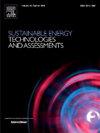焙烧对印度主要废生物质的理化和燃料性能的影响
IF 7.1
2区 工程技术
Q1 ENERGY & FUELS
Sustainable Energy Technologies and Assessments
Pub Date : 2025-03-17
DOI:10.1016/j.seta.2025.104277
引用次数: 0
摘要
作为可持续能源资源和有效废物管理的关键组成部分,生物质能源生产的重要性日益增加,这就需要全面了解生物质原料的基本特性。本综述严格评估了印度七种广泛使用的生物质来源(甘蔗渣、甘蔗顶、稻壳、稻草、玉米秸秆、玉米棒子和空棕榈油果束)的物理化学和燃料特性,特别关注烘焙的影响。尽管热处理在改善生物质特性方面有充分的证据,但有限的研究比较了这种热预处理过程在不同生物质来源中的具体效果。这篇综述通过批判性地分析烘焙对关键生物质特性的影响,包括半纤维素、纤维素、木质素、元素组成(碳、氢、氮和硫)、水分含量、挥发性物质和高热值,解决了这一空白,提供了一个比较分析,以确定能源应用的最佳生物质。此外,该综述还批判性地分析了烘烤对关键生物质特性的影响,包括半纤维素、纤维素、木质素、元素组成(碳、氢、氮和硫)、水分含量、挥发性物质和高热值。此外,本文综合了最近的研究结果,以确定提高每种相应生物质性能的最佳焙烧条件。通过对生物质特性及其实际应用之间复杂关系的全面分析,本综述有助于通过优化生物质能源系统和促进废物转化为能源的战略来推进可持续能源生产。本文章由计算机程序翻译,如有差异,请以英文原文为准。

Effect of torrefaction on the physiochemical and fuel properties of major Indian waste biomasses
The increasing importance of biomass-based energy production as a critical component of sustainable energy resources and effective waste management necessitates a comprehensive understanding of the fundamental properties of biomass feedstocks. This review critically evaluates the physicochemical and fuel characteristics of seven widely available biomass sources in India (sugarcane bagasse, sugarcane tops, rice husk, rice straw, maize stalks, maize cobs, and empty palm oil fruit bunches), with a particular focus on the impact of torrefaction. Despite the well-documented benefits of torrefaction in improving biomass properties, limited studies have compared the specific effects of this thermal pretreatment process across diverse biomass sources. This review addresses this gap by critically analyzing the impact of torrefaction on key biomass properties, including hemicellulose, cellulose, lignin, elemental composition (carbon, hydrogen, nitrogen, and sulphur), moisture content, volatile matter, and high heating value, providing a comparative analysis to determine the optimal biomass for energy applications. Moreover, the review critically analyzes the impact of torrefaction on key biomass properties, including hemicellulose, cellulose, lignin, elemental composition (carbon, hydrogen, nitrogen, and sulphur), moisture content, volatile matter, and high heating value. Furthermore, the review synthesizes recent findings to identify optimum torrefaction conditions that enhances the properties of each corresponding biomass. By providing a comprehensive analysis of the complex relationships between biomass characteristics and their practical applications, this review contributes to the advancement of sustainable energy production by optimising biomass-based energy systems and promoting waste-to-energy strategies.
求助全文
通过发布文献求助,成功后即可免费获取论文全文。
去求助
来源期刊

Sustainable Energy Technologies and Assessments
Energy-Renewable Energy, Sustainability and the Environment
CiteScore
12.70
自引率
12.50%
发文量
1091
期刊介绍:
Encouraging a transition to a sustainable energy future is imperative for our world. Technologies that enable this shift in various sectors like transportation, heating, and power systems are of utmost importance. Sustainable Energy Technologies and Assessments welcomes papers focusing on a range of aspects and levels of technological advancements in energy generation and utilization. The aim is to reduce the negative environmental impact associated with energy production and consumption, spanning from laboratory experiments to real-world applications in the commercial sector.
 求助内容:
求助内容: 应助结果提醒方式:
应助结果提醒方式:


